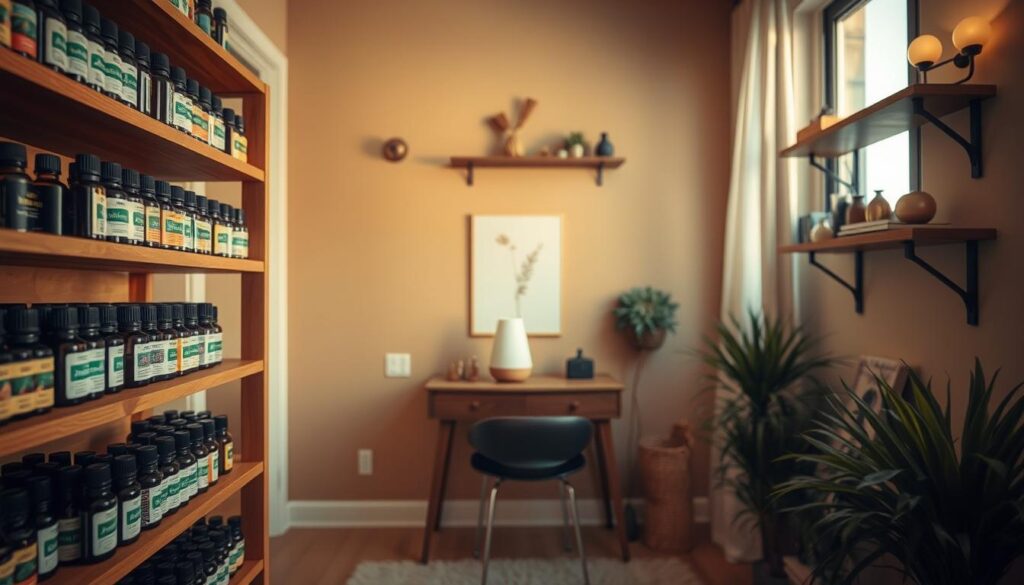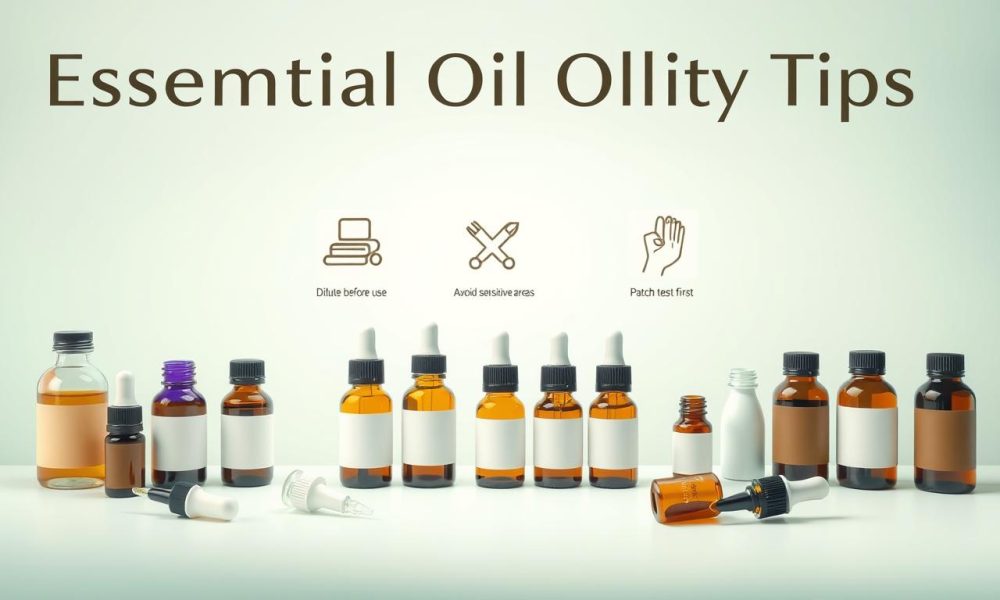Using essential oils can be great for your well-being. But, it’s important to do it safely. Your safety depends on your age, health, and other things you’re taking.
To use essential oils right, think about their chemical makeup, purity, and how you use them. Knowing these things helps you stay safe and enjoy the oils’ benefits.
Key Takeaways
- Understand the importance of essential oil safety for your well-being.
- Consider your age, health, and other medications when using essential oils.
- Be aware of the chemical composition and purity of the oils you use.
- Follow safe usage guidelines to minimize risks.
- Learn about the appropriate methods and durations for using essential oils.
Understanding Essential Oils
The world of essential oils can seem complex. Let’s explore the basics of these concentrated plant extracts. To use them safely and effectively, you need to know their nature and how they’re made.
What Are Essential Oils?
Essential oils are potent plant extracts that capture a plant’s fragrance and healing properties. They’re made by steaming or pressing different parts of plants, like flowers, leaves, or roots. Because they’re so concentrated, a little goes a long way.
When using essential oils, it’s important to follow essential oil tips and precautions to avoid bad reactions. Knowing each oil’s characteristics is key to safe and effective use.
How Are Essential Oils Made?
Essential oils are made through several methods, mainly steam distillation and cold pressing. Steam distillation is the most common, using steam to release the oil from the plant. Cold pressing is used for citrus fruits, extracting oil from the peel.
The quality of essential oils depends on the plant material, extraction method, and equipment used. High-quality oils are pure and free from contaminants, making them safe for use.
Benefits of Essential Oils
Essential oils are key in natural wellness, helping both body and mind. They come from plants and have been used for centuries. They help with health issues and improve overall wellness.
Common Uses of Essential Oils
Essential oils can be used in many ways to boost health and well-being. Here are some common uses:
- Relieving stress and anxiety
- Promoting a good night’s sleep
- Reducing pain and inflammation
- Improving mood and cognitive function
To get these benefits, it’s important to use essential oils safely. This means knowing how to dilute them and being aware of any allergies or sensitivities.
| Essential Oil | Common Use | Benefits |
|---|---|---|
| Lavender Oil | Promoting sleep, relieving stress | Calming effects, improves sleep quality |
| Peppermint Oil | Digestive issues, boosting energy | Eases nausea, improves mental focus |
| Eucalyptus Oil | Respiratory issues, relieving pain | Decongestant properties, reduces muscle pain |
The Aromatherapy Connection
Aromatherapy uses essential oils to improve physical, emotional, and mental health. By smelling essential oils, you can affect your brain’s limbic system. This system controls emotions, mood, and memory.
Aromatherapy is great for reducing stress and anxiety. It also improves mood and cognitive function. You can use a diffuser or apply diluted essential oils to your skin.
When using essential oils for aromatherapy, choose high-quality oils. Follow safe usage guidelines to get the most benefits and avoid risks.
Potential Risks of Essential Oils
Using essential oils can be risky if you don’t know how to use them safely. These oils are strong and can be harmful if not used right.
Skin Sensitization and Allergies
One big risk is skin sensitization. Essential oils can irritate the skin, cause allergic reactions, and more if used without dilution. Oils like cinnamon, clove, and lemongrass are very irritating. Always mix essential oils with a carrier oil and do a patch test first. You can find more about how to dilute them in Section 5.

Ingesting Essential Oils: A Dangerous Choice
It’s very dangerous to eat essential oils. Some essential oils are toxic when swallowed, leading to serious health problems. For example, eating too much wintergreen oil can poison you like an aspirin overdose. The American Lung Association warns against eating essential oils because of the health risks.
Effects on Pets and Children
Pets and kids are extra sensitive to essential oils. Some oils, like tea tree oil, can be toxic to pets. Kids might also get skin irritation or other bad reactions. It’s important to keep essential oils away from kids and pets and use them in places with good air flow.
Dilution Guidelines for Safe Use
To enjoy essential oils safely, proper dilution is essential. You might wonder why dilution is so important. Essential oils are very concentrated. Using them without dilution can cause skin irritation or other problems.
Proper Dilution Ratios
For most adults, mixing 1-3% essential oil with a carrier oil is safe. A 2% dilution is usually recommended for topical use. But for children and those with sensitive skin, a lower ratio is better.
For example, a 1% dilution means adding 6 drops of essential oil to 1 teaspoon (5 ml) of carrier oil. For a 3% dilution, add 18 drops to the same amount of carrier oil. Always start with a lower concentration if you’re not sure.
Carrier Oils Explained
Carrier oils are key for safe essential oil use. They dilute the essential oils and spread them evenly on the skin. Popular choices include coconut oil, jojoba oil, and sweet almond oil.
When picking a carrier oil, think about your skin type and how you plan to use it. For dry skin, coconut or sweet almond oil is good. Jojoba oil works well for most skin types because it’s lightweight and not greasy.
Choosing Quality Essential Oils
It’s important to know what makes essential oils high-quality. This knowledge helps you use them safely. Always choose pure essential oils from trusted brands.
Identifying Pure Essential Oils
Look for GC/MS reports when buying essential oils. These reports show the oil’s purity. Also, check the label for the botanical name and where it’s from. For more tips on using essential oils safely, visit this resource.
Reputable Brands to Consider
Some brands are known for their quality and honesty. Look at their sourcing, production, and what customers say. Here’s a look at some top brands:
| Brand | GC/MS Reports | Certifications | Customer Reviews |
|---|---|---|---|
| Brand A | Available | Organic, ISO | 4.5/5 |
| Brand B | Available | ISO, GMP | 4.2/5 |
| Brand C | Not Available | Organic | 4.0/5 |
By picking high-quality essential oils from known brands, you can enjoy aromatherapy safely. This way, you get the most out of your essential oils.
Storage Tips for Essential Oils
Storing essential oils right is key to keeping them effective and safe. Knowing how to store them properly is important.
Best Practices for Storage
Store your essential oils in dark glass bottles. Keep them away from sunlight and heat. This stops the oils from breaking down due to light.
It’s also important to store them in a cool, dry spot. Make sure they are out of reach of kids and pets.
Choosing the right storage is critical. Dark glass protects the oils from UV light, which can make them less effective or even spoil. Some say to store them in a fridge, which is good in warm places to keep them fresh longer.

Signs of Degradation in Oils
Essential oils can break down over time, losing their strength and possibly becoming dangerous. Look out for changes in color, consistency, or scent. If you see any of these, it’s best to throw the oil away.
Another sign is an off smell or if the oil’s texture changes. Always check your essential oils before using them, even if they’ve been stored for a while.
| Signs of Degradation | Description | Action |
|---|---|---|
| Change in Color | The oil becomes darker or lighter | Discard the oil |
| Change in Consistency | The oil becomes thicker or thinner | Discard the oil |
| Change in Scent | The aroma becomes unpleasant or different | Discard the oil |
“The quality of essential oils can be maintained by proper storage, which includes keeping them away from light, heat, and moisture.”
By following these storage tips, your essential oils will stay safe and effective for longer. Always pay attention to where you store them and check them often for any signs of spoilage.
Safety Precautions When Using Essential Oils
Essential oils can be great for your wellness, but safety is key. It’s important to know the risks and how to avoid them. This way, you can use these powerful oils safely every day.
Patch Testing Importance
Always do a patch test with a new essential oil. Mix it with a carrier oil and apply it to a small skin area. Wait 24 hours to see if it causes any irritation. This step is vital to avoid bigger problems later.
If you’re new to essential oils, start with gentle ones like lavender or chamomile. These are safer for people with allergies or sensitivities.
Avoiding Sun Exposure After Use
Some oils, like citrus-based ones, can make your skin more sensitive to the sun. This is called phototoxicity. To stay safe, don’t use these oils on skin that will be in the sun. Or wait a while before going outside.
| Essential Oil | Potential Risk | Precaution |
|---|---|---|
| Bergamot | Phototoxicity | Avoid sun exposure for 12-24 hours after application |
| Lemon | Phototoxicity | Avoid sun exposure for 12-24 hours after application |
| Peppermint | Skin irritation | Dilute with carrier oil before applying to skin |
Knowing the risks and taking precautions lets you enjoy essential oils safely. Always check the labels, follow the guidelines, and talk to a doctor if you’re unsure.
Essential Oils and Pregnancy
Expectant mothers often wonder about the safety of using essential oils during pregnancy. Pregnancy requires careful consideration of the products and substances used. Essential oils, while beneficial, can pose risks if not used correctly.
It’s crucial to consult healthcare professionals before using essential oils during pregnancy. They can guide you based on your health and pregnancy stage.
Oils to Avoid During Pregnancy
Some essential oils can have adverse effects during pregnancy. For example, clary sage and pennyroyal can stimulate the uterus, leading to complications. Also, avoid wintergreen and birch because of their high methyl salicylate content, similar to aspirin.
| Essential Oil | Potential Risk |
|---|---|
| Clary Sage | Uterine stimulation |
| Pennyroyal | Uterine stimulation, toxicity |
| Wintergreen | High methyl salicylate content |
| Birch | High methyl salicylate content |
Safe Essential Oils for Expecting Mothers
Some essential oils are safe to use during pregnancy with healthcare provider guidance. Lavender oil can help with sleep. Frankincense oil may reduce stress and anxiety. But, use these oils in diluted form and in moderation.
For more information on using essential oils during pregnancy, visit WebMD’s guide on essential oil safety during pregnancy. This resource offers detailed insights and expert advice.
By being informed and cautious, expectant mothers can enjoy essential oils’ benefits while minimizing risks. Always consult healthcare professionals to ensure a safe and healthy pregnancy.
Essential Oils for Children
Using essential oils on kids needs careful thought and knowledge. Essential oils can be beneficial, but they must be used with caution. This is because children have sensitive skin and are growing.
When picking essential oils for your child, choose safe and gentle ones. Some recommended essential oils for kids include lavender oil for calming, tea tree oil for its antiseptic properties, and chamomile oil for soothing.
Recommended Oils for Kids
Some essential oils are safer for kids than others. For example:
- Lavender oil can help with sleep issues and anxiety.
- Tea tree oil is useful for minor cuts and scrapes when properly diluted.
- Chamomile oil can soothe irritability and promote relaxation.
Make sure to properly dilute these oils before applying them to your child’s skin.

Safety Guidelines for Children’s Use
To safely use essential oils on children, follow these guidelines:
- Always dilute essential oils with a carrier oil before applying them to your child’s skin.
- Perform a patch test to check for any adverse reactions.
- Consult with a healthcare professional before using essential oils on infants or children with health conditions.
- Keep essential oils out of reach of children to avoid accidental ingestion.
By following these essential oil tips, you can ensure a safe and beneficial experience for your child.
For more detailed guidance, consider consulting resources dedicated to the safe use of essential oils in pediatric care. This will help you stay informed about the best practices for using essential oils with your children.
Safe Diffusion Practices
Using essential oils safely is key to getting the most out of them. Diffusing these oils can make your space better, lift your mood, and help your health. But, you need to use your diffuser right and follow some important rules.
Types of Diffusers
There are many diffusers out there, each with its own special features. Knowing these differences is important for safe and good use.
Nebulizing Diffusers: These are very effective. They spread pure essential oil particles in the air without water or heat, keeping the oil’s benefits.
Ultrasonic Diffusers: These use sound waves to make a fine mist from water and oil. They also work as humidifiers.
| Diffuser Type | Characteristics | Best For |
|---|---|---|
| Nebulizing | Direct diffusion, no water or heat | Strong, therapeutic benefits |
| Ultrasonic | Creates a mist, can be used as a humidifier | Humidifying and aromatherapy |
| Evaporative | Uses a fan or heat to diffuse oils | Simple, cost-effective diffusion |
Recommended Room Sizes and Duration
When using your diffuser, think about your room’s size and how long you’ll run it. For a room about 100-150 sq. ft., use 5-10 drops of essential oil.
In bigger rooms, you might need more drops or use more diffusers. For smaller rooms, start with fewer drops and adjust as needed.
Duration Guidelines: Diffuse for 30 minutes to 1 hour at a time, with breaks in between. Diffusing too long can cause health problems.
By following these tips and picking the right diffuser, you can safely enjoy essential oils’ benefits.
Responding to Essential Oil Emergencies
Knowing how to act in an essential oil emergency is key. Essential oils are usually safe, but accidents can happen. Being ready can save time and prevent harm.
If you have a bad reaction to an essential oil, stay calm and act fast. Learn the right first aid steps and when to get medical help.
First Aid Measures for Reactions
For skin irritation or allergic reactions, follow these steps. First, immediately remove any contaminated clothing. Then, wash the affected area with mild soap and lukewarm water. For eye exposure, flush with water for at least 15 minutes.
If you swallow an essential oil, do not induce vomiting. Call a poison control center or a doctor for advice. Having the essential oil’s label handy can help.
| Reaction Type | First Aid Measure |
|---|---|
| Skin Irritation | Wash with mild soap and lukewarm water |
| Eye Exposure | Flush with water for 15 minutes |
| Ingestion | Contact a poison control center or healthcare professional |
When to Seek Medical Attention
Many reactions to essential oils can be treated with basic first aid. But, some need medical help. If you have severe symptoms like trouble breathing or a fast heartbeat, seek medical help immediately.
Children, pets, and people with health issues should see a doctor for any reaction. Even small reactions can be serious for them.
Being prepared for essential oil emergencies is important. Always use them responsibly and follow safety rules. This way, you can avoid most risks.
Continuing Education on Essential Oil Safety
To use essential oils safely and effectively, it’s important to keep learning. Knowing the best practices for essential oil safety is key. This knowledge helps you understand the risks and benefits of these powerful oils.
Resources for Further Learning
There are many resources to help you learn more. Look into organizations like the National Association for Holistic Aromatherapy and the Alliance of International Aromatherapists. They offer valuable information and guidelines on safe practices.
Staying Up-to-Date
Keeping your knowledge up-to-date is essential. It helps you navigate the complex world of aromatherapy confidently. By staying informed, you can enjoy the benefits of essential oils while avoiding risks.























